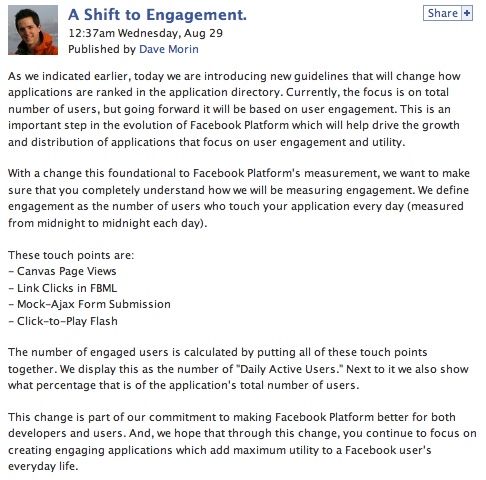Engagement is vital for authentic learning. Without engagement, learners are unlikely to experience “transfer” of ideas, images, and skills from a lesson into their long term memory and schema. On Friday I recorded and shared some thoughts about the implications of the “attention economy” for teaching and learning in the 21st century. One of the recipes for authentic learning I shared in that podcast was:
Participation –> Attention –> Engagement
I probably used the word “formula” in the podcast, but I really like the metaphor of a “recipe” better than “formula” because it implies some general instructions which are changeable based on the discretion of the chef and the context of the meal being prepared.
I learned today (via a Facebook message from B.J. Fogg) that Facebook recently announced a new “metric” for measuring the value of different applications that focuses on ENGAGEMENT. Rather than just measuring the number of times an application has been installed, Facebook developers have created a scheme which evaluates and scores multiple “touch points” for different applications.
How are you measuring engagement in your classroom? I think Facebook developers are modeling a path of focusing on “engagement” which goes beyond initial participation (software installation) that we need to follow in our classrooms. Some of the questions Tim Tyson posted during his keynote at BLC 2007 could serve as useful components of an “educational engagement” metric in classrooms:
- Who is asking the most questions in your classroom?
- Who is doing the most thinking in your classroom?
Conversations, particularly spontaneous conversations which are initiated by students, can be a good sign of engagement and engaged learning in the classroom.
As we continue to hear more about “educational engagement” and its value for learning, I think we need to increasingly focus on integrating measures of engagement within the assessment methods we use along with our students. Blog reflections, wiki document contributions, and created digital stories can be clear signs of student PARTICIPATION in required tasks for a class or course. Mere participation does not necessarily correlate to ENGAGEMENT or engaged learning, however.
What good metrics for educational engagement which go beyond mere “participation” have you used or seen in action?
Technorati Tags:
assessment, engagement
If you enjoyed this post and found it useful, subscribe to Wes’ free newsletter. Check out Wes’ video tutorial library, “Playing with Media.” Information about more ways to learn with Dr. Wesley Fryer are available on wesfryer.com/after.
On this day..
- Lessons Learned with Website eBook eCommerce Continue (August 2018) – 2018
- Interview with Author & Screenswriter Rene Gutteridge – 2015
- A Case Study: How NOT to Set Up a WordPress Site – 2011
- Creating a course audio lecturecast (podcast) with Podcast Generator – 2010
- Why ALL Learners Need Laptops NOW! (SlideShare Slidecast) – 2010
- What questions do you have about copyright? – 2009
- Proposed Fall Conference Sessions – 2009
- Believe in your students, colleagues, and believe in yourself – 2008
- Darfur Issues highlighted via a student-created Southpark style video – 2008
- Copyright and recording full-length library books – 2008


Comments
One response to “Measuring engagement”
[…] excellent Moving at the speed of creativity blog has an interesting post today on “Measuring Engagement“. Engagement is, I think, a key quality of a healthy life. But what does it mean […]